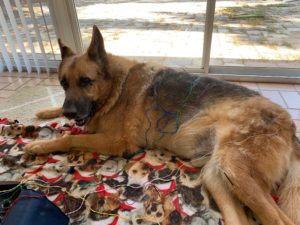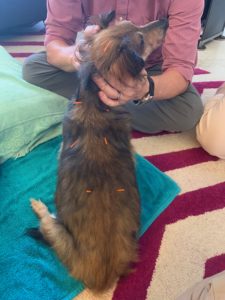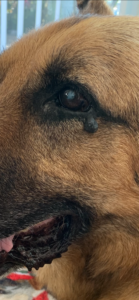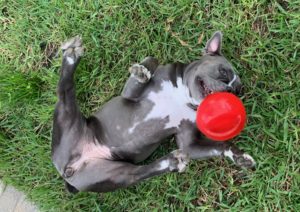Holistic, Integrative & Functional medicine house calls for Tampa Bay pets.
Email DrTruli@VetVMD.com or Text (813) 714-7863
Dr. Sandra Truli Springer, VMD, MS-TCVM, CVA, CVFT, CVTP, CVCH, CTCVMP, CTPEP, CVMMP
Veterinary Medical Doctor, University of Pennsylvania Ivy-League.
Master of Science- Traditional Chinese Veterinary Medicine.
Acupuncturist, Food Therapist,Tui-na (medical massage), Herbalist, Veterinary Medical Manipulation Practitioner.
Fellow of the American Academy of Veterinary Acupuncturists.
Human Animal Bond Certified.
Founding Member of the Nutrition Innovation Council.
What is Real Food for Dogs?
Real food is basic unprocessed ingredients cooked for your dog. Preferably fresh, non-GMO, organic if you can get them. Common sense says real food will taste good and make for a calmer, healthier pet. Real food can be an act of love and caring from you to your pet. It feels good to feed your dog or cat actual real food!
How is Real Food “Done?”
Cook at Home
The basic way is to get a meal plan of balanced recipe designed by a qualified veterinarian and cook up the food for your pet on a daily or weekly basis. If your dog is tiny, you might be able to cook up to 3 weeks’ worth and freeze meal-size portions for consumption later. These meals are typically crock pot or casserole or meatloaf-type recipes. Once you are a registered client with Dr Truli, you can get custom designed meal plans, computer balanced with proper nutrients for confident real-food care. Call Dr Truli at (877) 378-7854 or email DrTruli@VetVMD.com to get started today!
Get a Doggy Chef
You can have a doggy chef cook balanced meals for you. How this works is, you have a qualified veterinarian examine your dog and either design the meal plan for you or hire a veterinary nutritionist. You get recipes you can then share with your doggy chef. Some online companies offer an in-house service to make recipes for your pet. Be aware that this in inaccurate and a violation of veterinary medicine practice acts in many states unless the person making the recipe is a veterinarian and has examined your pet personally. Why does this matter? There are 100’s of medical conditions that affect nutritional needs. Like bladder stones, IBD, allergies, etc.
Buy meals at a doggy cafe
The next way to feed real food is to buy meals for dogs pre-made. Many dog cafes and eateries are popping up in cities across America. It is a whole new world of options. These meals cannot be balanced for your pet because they are made for dogs in general. They can provide fun and variety and it is unknown of they would cause nutritional imbalances if fed exclusively and long-term. (Long-term meaning for more than 2 months.)
Have fresh meals delivered
Another way to feed your dog real food is to have a delivery service that brings prepared whole foods meals to your doorstep. These are available in some urban areas in the US. These meals, while delivered to your door, are still not balanced for your pet.
Get close with certain prepared foods
Companies like Honest Kitchen and Pet Tao and Simple Food Project make food according to Chinese Veterinary Medicine principles of food combining. They source the ingredients as locally and organically as possible, but 100% organic is only possible with home-cooking.
Work With a Veterinarian Who Understands Food
Dr Sandra Truli Springer provides house calls for pets in the Tampa Bay, Florida area. Dr Truli will not only respect your feeding choices, she can guide you to optimize whatever you are doing. In her next post, Dr Truli will address what laboratory tests you should be doing if you are cooking for your dog or cat.
Start feeding your pet right in the new year. Call Dr Truli at (877) 378-7854 or email DrTruli@VetVMD.com to get started today!
What is a Senior Dog?
First of all, let me say, it drives me batty when a dog is considered “senior” at 7 years old. Why is that senior?
In this post, guess the dogs’ ages from their pictures (answers at the end of the post):
Microchipping Dogs Saves Lives
Clients often ask, “Would you do it if it was your dog?” In answer to microchipping, I would, and I did. Microchips are slightly bigger than a grain of rice. They go under the skin between a dog’s shoulder blades. They send a radio signal that can be scanned for identification purposes. Meet Lyta, Missy and Merlin. They are my lovely Shepherds and I microchipped them. If you would like your pets microchipped, call Dr Truli’s toll-free line (877) 378-7854 to schedule a house call today.
“I provide microchipping services in the comfort of your home for cats, dogs and ferrets,” says Dr. Truli. “Professional microchipping takes 1 second. The chip should last their lifetime.”
- Lifetime Registration included (no additional charges ever)
- International travel and US travel compliant
- Lost pet reunion with your family
- Quick, convenient and comfortable in your home
One benefit of having Dr. Truli microchip your pet is the lifetime registration. For one up-front payment, you get the chip and your pet is registered for life in the recovery database. This means you can add new addresses and contact information for the life of your pet without ever paying anything additional.
A second benefit is the microchips are US and International standard chips. This means you can use the microchip for ID for Rabies titers, EU Pet Passports, and international travel documents.
The biggest benefit is any veterinary hospital, animal control officer, or animal shelter should be able to scan for the microchip number, call the database, and access your contact information quickly. Pets that become run away, get lost, or get separated from their family in an accident or a storm can be quickly reunited with their family.
Call Dr Truli toll-free today and schedule a microchipping appointment in your home. (877) 378-7854
How do I avoid Anesthesia for my Older Dog?
Anesthesia can age an already older pet. There may be groggy hours or days of recovery, digestive upset, stiffness or achyness from positioning during the procedure. You may be wondering if anesthesia is the only way to go? And if it is, what can you do to help your dog bounce back better than before the anesthesia? A holistic house call veterinarian with over 20 years experience, Dr Truli offers tips and alternatives you may not have already thought of.
-
Get a second opinion
- After 20 years of surgeries, Dr Truli’s Tampa Bay area practice is now 100% house calls with no surgery. “If I recommend surgery, I make zero money from that recommendation. You know I truly feel the surgery is in your pet’s best interest,” says Doc Truli.
-
Get a proper diagnosis
- diagnosis: vomiting versus regurgitation “Vomiting involves active abdominal retching. If it ‘just comes up’ especially after your pet has just been sleeping, it is likely regurgitation. Why does it matter? If it is vomit, we look in the abdomen for the problem. If it is regurgitation, we look in the chest,” says Doc Truli. You might be getting x-rays of the wrong part of the body!
- diagnosis: diarrhea versus constipation “Diarrhea and constipation can look identical. Your dog is doing the squat-walk around the yard and nothing comes out. Most people assume it is constipation. Usually it is diarrhea. Opposite treatment,” says Doc Truli.
- diagnosis: coughing versus choking “Coughing can look like choking. Choking is a life-threatening emergency. If you think your dog is choking, do not hesitate to go to the pet ER,” Doc Truli.
- diagnosis: bacterial skin infection versus yeast infection versus skin cancer “Bacteria, yeast, ringworm, mites and skin cancer can look identical. You need proper non-invasive testing,” says Doc Truli.
-
Ask explicitly about alternatives to surgery
- alternative: new medical treatments “Will acupuncture work just as well as or better than surgery?” asks Doc Truli. What else might work?
- alternative: rest and painkillers “Does the surgery improve the outcome, or is it the same? Many times knee surgery can be avoided with rest, painkillers and physical techniques like professional massage and exercises for healing,” sys Doc Truli.
- alternative: how many dogs get better on their own? If you do nothing, will your dog get better? The classic example is ear hematoma surgery. A dog will likely get better on its own without surgery, but it can be painful and take longer than if you have a surgery performed.
-
Can the procedure be done with local numbing?
- local anesthesia reduces need for deep anesthesia
- many skin tags and small lumps and skin biopsies can be performed with local numbing. A calm, complaint dog that does not mind laying on a table under surgical lights is the ideal patient for non-anesthesia procedures.
- your dog needs help to decrease anxiety and pain with local anesthesia “Local anesthesia numbs the sensation from the area. But most dogs do not understand the hospital environment and feel anxious. Anxiety increases perception of pain,” says Doc Truli
- local anesthesia reduces need for deep anesthesia
-
Can the procedure be done with light sedation?
- light sedation: lump removal small lumps in a calm dog, especially on an easy to heal area like the trunk of the body or the top of the head are candidates for non-anesthesia surgery
- light sedation: diagnostic testing
- ultrasound usually no sedation is needed. Some dogs fidget or pant and must have a light sedative so the ultrasonographer can see the computer images.
- allergy skin testing is performed with light sedation. It may be more difficult to explain to your itchy dog why they are being shaved in a dermtologist’s office than explaining skin testing to your child.
- diagnostic biopsy, especially bone marrow biopsies can be quite painful and scary. Sedation is considered necessary for bone marrow biopsies.
-
Does my dog need anesthesia?
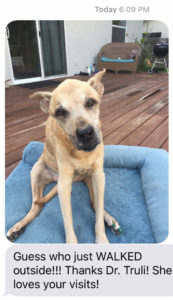
This girl would likely not survive surgery. Happy Patient after massage, acupuncture and injections to help severe arthritis & weakness.
- anesthesia: would the procedure be less stressful for my dog?
- tumor removal in a nervous dog. Will your dog remember the procedure and never accept a veterinarian’s help again unless zonked by sedation? Perhaps it is better to let your dog sleep through this episode, instead of developing a mental complex.
- anesthesia: would the procedure be faster?
- if your dog needs to be held still. Think about your dog standing and sitting, standing and sitting, panting, spinning, while your veterinarian tries to suture closed an incision on your dog’s side. It is likely to take an hour instead of 10 minutes!
- anesthesia: would the results be better?
- more thorough visualization
- ability to move the body parts and get to the area “I admit, back in the day, sometimes I wish I would have put certain dogs under anesthesia instead of taking 4 nurses and an hour to do a 1 nurse 10 minute procedure with only local anesthesia,” says Doc Truli.
- is the procedure impossible without anesthesia?
- dental x-rays. Nope. No. It is not possible to take diagnostic quality dental x-rays in an awake dog. Why? If you ever had dental x-rays, remember when they said, “Now hold your breath for a minute?” That’s why.
- painful surgeries: bone, knee, hip, back. Just grueling. Only battlefield conditions would make me want to do these surgeries without anesthesia.
- anesthesia: would the procedure be less stressful for my dog?
-
What can I expect my dog to go through if they do not have the surgery?
- Always ask yourself and your veterinarian: is the surgery better than the problem in the first place? For example, bilateral mastectomy on a 12 year old dog with pre-cancerous lumps. An intensive, extensive large surgery might make her weaker.
- “I saw a dog years ago with a large red lump on the top of his nose. It was a mast cell tumor. Surgery was needed to cure it. But the family did not want his nose disfigured and frankly, it was an expensive surgery. The dog lived 3 more happy years, then suddenly passed from cancer-related disease. 15 was pretty good!” says Doc Truli.
Call or email Dr Truli today! Call toll-free (877) 378-7854 or email DrTruli@VetVMD.com
Dr Truli completes the Masters of Science in Traditional Chinese Veterinary Medicine
The confirmation came through today, May 1st, 2019. Yours Truli has completed the MS in TCVM degree at the Chi Institute in Reddick, Florida. Dr Truli’s Master’s thesis original research project investigated 5-Element Canine Personality types and the diseases that befall them.
Dr Xie wrote, “you have made the history” with this first-of-its-kind study.
MS-TCVM
The Master’s of Science in TCVM is 36 credit hours total and took 3 1/2 years to complete. 25 core subject hours cover acupuncture, tui-na medical massage, chinese herbal medicine and food therapy. 6 hours are assigned to the unique, original research Master’s thesis. 5 hours are electives. Dr Truli studied advanced acupuncture, advanced tui-na, Chinese medicine ophthalmology, evidence-based acupuncture and palliative and end-of-life care elective education topics. The thesis alone took a year to gather the data and a year of writing and editing before thesis committee approval.
In addition, Dr Truli studied Topographic acupuncture with Dr Bruce Ferguson. This minimal-needle acupuncture technique can eliminate pain and restore function to many animals with only 1-3 needles.
To inquire if Dr Truli can accept your pet as a patient, please email DrTruli@VetVMD.com with your pets name, your name, address, and contact information and a brief description of your goals in working with Dr Truli.
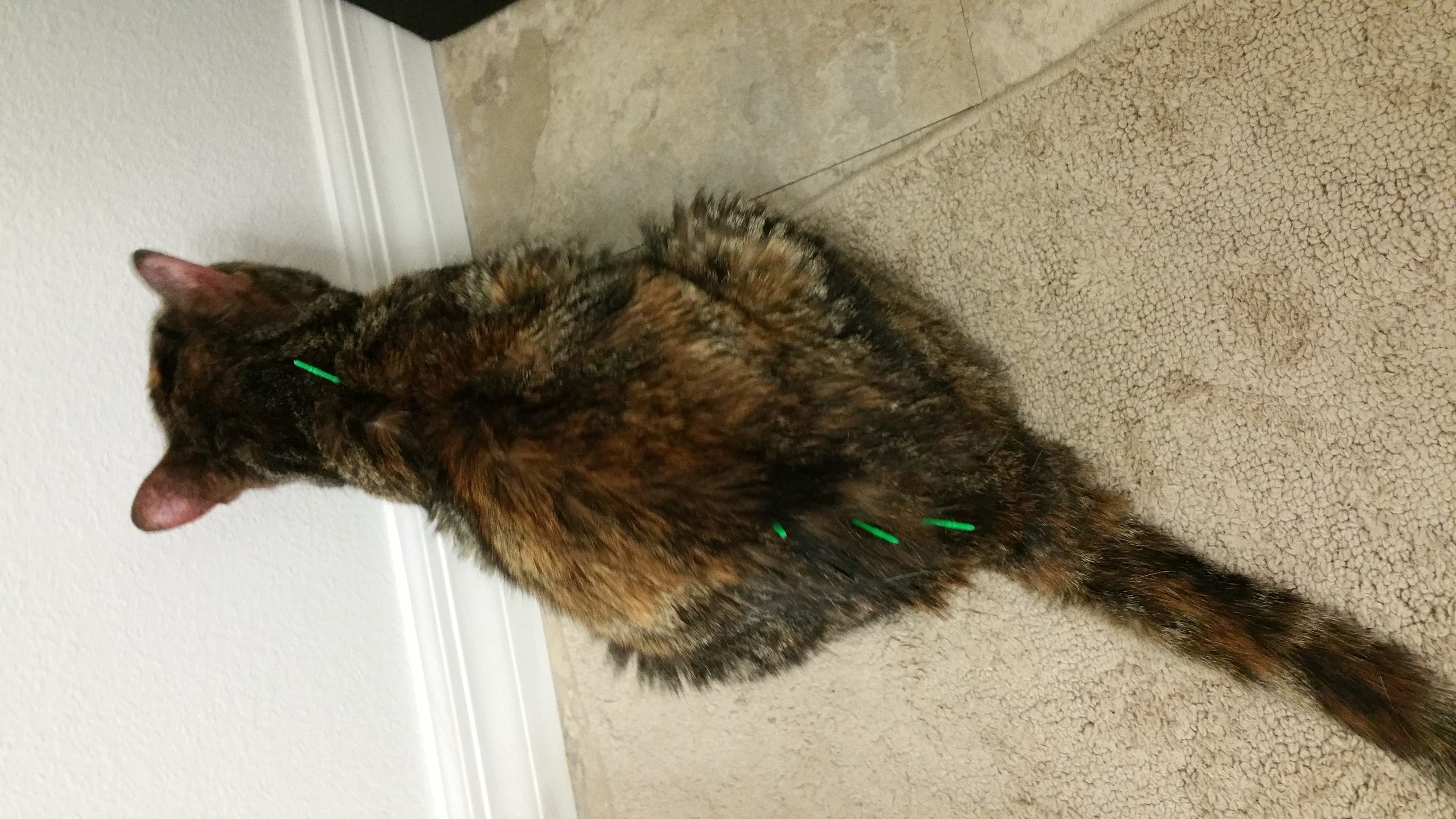
“My Cat Is Getting Old.”
Really? Old age is not a disease.
Here are some common things Doc Truli hears when a cat actually has arthritis, disc disease or hip dysplasia:
- “She takes a long time to line up a jump.”
- “He doesn’t get up on the bed anymore.”
- “She hates when I touch her lower back.”
- “He used to chase the lizards all.the.time.”
- “I thought she was just getting old.”
If you notice your cat’s habits and behavior changing, there’s a good reason. You should schedule a check-up with your trusted family veterinarian or an integrative, holistic-minded veterinarian.
Why Slow Twitch and Fast Twitch Muscles Matter to Your Cat
Your cat will never admit it, but they care about fast twitch muscles especially. Why? Cats have more fast twitch muscles than people and dogs. What on earth are fast twitch muscles? Let me explain.
There are so-called slow twitch and fast-twitch muscles in the body. The slow twitch are what we generally use for prolonged activity, like distance running. Cats have more fast-twitch muscle fibers than humans. That’s why the Cheetah holds the mammal land-speed record and not a human!
Fast-twitch muscles have explosive-type action. For example, a cat has many more fast-twitch muscles in their haunches than humans. They use them to jump from the floor to the top of a grandfather’s clock in one leap, for instance. Most dogs and humans cannot create a burst of muscle activity that launches the body up 10 or 20 times their height! That would be like an average person jumping up to a balcony on a 5 or 6 floor building in one jump. That is what cats do when they jump unto your door frame, or the kitchen cabinets, or the grandfather’s clock, or an unfortunate curtain rod.
Of course, not all cats are that motivated or athletic, but even a ordinary cat can jump up onto the bed. That is 4-5 times their height! The kitchen counter…can your dog get up there acutely, confidently in 1 leap? We expect our cats to make a jump like that unless they are a differently-abled cat. We expect it so much that – be honest- we either get startled and alarmed if they miss, or we stifle a muffled laugh. Because cats usually don’t miss. That’s fast-twitch muscles in action.
Why Fast Twitch Muscles Matter to Your Older Cat
The Type II fast twitch muscles deteriorate quicker than the Type I slow twitch muscles as we age. The fast twitch muscles help us with that burst of muscle activity we need to get up out of a comfy chair – or off the toilet! We start having trouble “getting up,” and start relying on that brushed stainless steel helper-handle in the handicapped stall at a restaurant. But really, we notice we need to push up off the chair arms instead of just using our legs as we age. That is fast twitch muscle loss. And we lose it before the slow twitch muscles.
Now, imagine you are a cat. You are made of fast-twitch muscles compared to your humans! So what goes first? Your ability to “get up.” First the cabinet-tops, then the counter, then the bed, then the sofa, then the stairs, then…you “sleep a lot.” (More than a younger cat.) So likely the very first sign your cat is aging and needs holistic help is inability to jump and “get up” like they used to.
What About the Cat Arthritis?
Arthritis is thought to be a degenerative condition. In other words, it doesn’t happen over night. We miss the signs along the way that our pets are headed for pain. Loss of fast-twitch fibers evidenced by decreased jumping are subtle early signs your cat could use some veterinary help. Treatments like cold laser therapy, EMF, medical massage, physical therapy, nutritional support, acupressure, acupuncture and electro-acupuncture show promise to help cats age gracefully. These treatment modalities are all the practice of veterinary medicine in the State of Florida. Be certain the person you hire to help you is licensed to practice on your cat.
-Dr Truli is available for in-home evaluations for the Tampa Bay, Florida area. Please call (877) 378-7854 for appointment availability.
If you are not in the Tampa, Florida area, you can find a Integrative Medicine veterinarian by:
- ask your veterinarian if they have training in these modalities or if they can refer to a trusted colleague in your area
- go to tcvm.com under resources and “find a practitioner” – this is a worldwide search database
- go to ahvma.org under practitioner search – this is mostly United States, but also some worldwide members in the database

When Should You NOT Vaccinate
If your dog had a documented veterinary-treated vaccine reaction, they should not receive that vaccine again. If your dog’s close relatives or family have documented reactions, you likely should not vaccinate your dog. If the reaction was to a legally required Rabies vaccine, it may still be available as a vaccine for your dog if your dog is pre-treated to help prevent anaphylaxis. Tell your veterinarian about vaccine reactions and bring the documentation to the visit. They will advise you.
What Likely IS a Vaccine Reaction:
- anaphylaxis – this is an emergency, go to the vet!
- hives
- lowered blood pressure
- shock
- face swelling
- seizures
- coma
- paralysis
- pass out
- stumble, stagger, “drunk”
- vomiting and diarrhea (may or may not be, call the vet)
Possibly not an Allergic Vaccine Reaction- ask your vet
- feeling tired
- sleeping more for 12-24 hours
- not eating breakfast
- a little soft stool
- tenderness at the injection site
- lump that goes away
-Dr Truli provides as much time as you need to discuss lifestyle, risks, and your concerns about vaccines. Vaccines are not “business as usual” and you need a veterinarian and veterinary team who understands you are the best pet parent when you question the standard-of-care.

“I don’t want to give my dog any unnecessary vaccines.”
Who does? thinks Doc Truli.
We get the point. You want a veterinarian and veterinary team that is thoughtful and specific about what vaccines they recommend for your puppy or dog and why. Unfortunately, many veterinary teams offer “customized packages.” You may pay less for the package and get more, but you may get vaccines you don’t need. For example, have you heard a friend say, “they told me it would cost more to take the bordetella vaccine out of the package. So I just went ahead and got it anyway.”
It hardly makes sense, does it?
Prescription for Care
Vaccines should only be administered to healthy animals. It says so on the package! Your veterinarian needs to consider your pet’s lifestyle, the prevalence of the disease in your area, the route(s) of transmission, the severity and forms of the illness, whether it is transmissible to humans or not, and the effectiveness of the vaccine.
Your previous experiences with certain diseases, your risk aversion (how bad will you feel if your dog caught a rare, painful, but preventable disease?), and your preferences for medicalization for your family will guide your decisions.
Rabies Vaccine
For instance, most people do not have personal experience with Rabies. (Most veterinarians do.) But the disease is deadly to humans, expensive and painful to treat in humans (if you know you have been exposed and get the treatment right away), deadly to our dogs and cats, horses, and most other domestic animal species. Rabies is relatively cheap to prevent. Veterinarians have a public health duty to society to help stop rabies from spreading.
There are possible side effects from the vaccine. They are statistically rare. They can be deadly. If you decline a rabies vaccine in case there is a side effect, you really cannot understand what you are risking for your pet and your family unless you have been through it before. If you have had rabies in your family, I bet you will want that vaccine. Like, yesterday!
The seriousness of the public health risk, the deadliness of rabies, and the ease of spread in wildlife populations are 3 good reasons it is the law to vaccinate domestic animals in the US.
Distemper Vaccine
Distemper is an often fatal dog virus. It spreads through secretions, especially snotty noses in crowded environments like some animal shelters. It causes a really high fever and pneumonia symptoms and if the dog survives, they have neurologic signs like seizures when they are older. The vaccine works well and the disease is bad. It is considered a dog “core” vaccine in the US.
Here’s a little-known reason why this vaccine is important: distemper mutates and crosses into other species than dogs. For instance, dog distemper virus kills sea lions really well. And we do not want that! You are helping other innocent animals when you provide protection for your dogs.
Parvo Virus Vaccine
Parvo virus is a very contagious dog virus that causes vomiting and bloody diarrhea. You carry the virus on your shoes and clothing and do not know you are bringing it home with you. Many infected puppies die from it. Adult dogs can get very sick. It is difficult to save them with or without intensive care in the hospital. The vaccine is effective and also considered a core vaccine for dogs.
Other Vaccines
There are several other common dog vaccines available in 2018. Parainfluenza, Hepatitis, Bordetella, Canine Influenza Types 1+2, Leptospirosis, Coronovirus and Lyme disease to name a few. They are considered non-core vaccines and should warrant an especially careful discussion with your veterinarian.
A Word About Thimerosal
Thimerosal is ethyl mercury. It is found as a preservative in some dog vaccines. If a vaccine says “preservative-free” on the label, it may contain minute amounts of thimerosal. If it says “thimerosal-free” it contains no thimerosal. Of course, we would like to decrease lifetime exposure to mercury in any ways we can control. Using thimerosal-free vaccines is one was to accomplish this.
Market availability and manufacturing change, so a list will not suffice to be posted here. Your veterinarian or veterinary technician can provide the information for you for the vaccines they recommend. Sometimes compromises must be made if a valuable useful vaccine is unavailable thimerosal-free at the time.
You can also ask the brand name and look up the “package label insert” for the product. They are usually posted online and you can read it for yourself.
-Doc Truli provides holistic house calls to the greater Tampa Bay area. Many, many clients call Doc Truli for an objective, thoughtful consultation about vaccines without recrimination or hard feelings.
“The best pet parents question the standard of care and want better for their loved ones,” Doc Truli.
Email DrTruli@VetVMD.com any time of day or night to find out appointment availability for your area. (Doc Truli understands these pet concerns keep us up at night. She will get back to you in the morning!)

“Is there a blood test for cancer in dogs?”
“I hear this question all the time. I used to have to say no.” says Doc Truli. “Now there is a clinically available test.”
Veterinary Diagnostic Laboratories in California have adapted blood tests from human medicine for dogs. They have spent 11 years working on the technique and validation of the tests. For 4 years, they have offered a test for veterinarians to prescribe in their practices in the US.
Cancer Blood Test for Dogs
The test is called the InCase Wellness to screen for markers of possible cancer. The procedure is a simple blood draw for your pet. The veterinarian must then process and prepare the sample specifically for the testing. The InCase Wellness tests for TK1 cancer marker, CRP (C-reactive protein) inflammation marker, and your veterinarian can request a Vitamin D3. Vitamin D3 is sub-optimal or low in 75% of the dogs tested. It is easy to fix and retest to make sure you have not given too much. (Vitamin D3 causes gastrointestinal distress, kidney failure and death when it is too high.)
Cancer Remission
The TK1 and CRP tests can be used to identify when a dog is in remission. It is testing especially useful in lymphoma cases and many other types of cancer. The tests can also be used to detect if a dog is coming out of remission before the dog feels sick again.
You can read more about these stunning and helpful cancer tests for dogs at vdi labs.
-Dr Truli provides VDI testing such as the InCase Wellness, Cancer monitoring tests Vitamin D3 testing in a comforting house call environment.
Call, email or text for appointment availability. Provide your name, phone number, street address, and a brief description of your pet’s diagnosis or current problem.
Leave a message and the doctor will call you back in 24 hours or less: 877-378-7854.
Text 813-714-7863 and Dr Truli will text.
Or email DrTruli@VetVMD.com and Dr Truli will email back.





